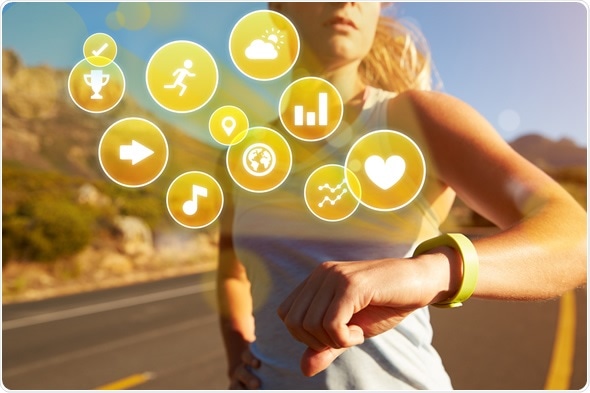Gadgets that are worn on the body and track certain parameters of the body’s functioning are known as wearable fitness trackers. There are three primary uses for these trackers:
- Monitoring the number of steps that a person walks.
- Checking the heart rate of the individual.
- Monitoring the quality of sleep of the individual.
With technological advances, many fitness trackers on the market are able to monitor all three of these parameters and provide valuable insight into the health of the person wearing the tracker.

Image Copyright: Monkey Business Images / Shutterstock
Pedometers
These are fitness trackers which allow a person to keep track of the number of steps that they take each day. A sensor may keep track of the motion that the person makes allowing the data to be collected all through the day. The data is later sorted and analyzed, allowing the person wearing the tracker to know how many steps they have walked in a certain duration of time. This gadget may also use the GPS feature, to keep a track of the actual distance a person walks or runs in the real world. The trackers measure acceleration, frequency, duration, intensity and patterns of the wearer’s movements to complete their analysis.
Heart Rate Monitor
Fitness trackers use sensors to keep track of the heartbeat of the person wearing the gadget. The data is collected and compiled to give a summary of how the heart rate behaves throughout the day. This is useful for people with blood pressure problems to gage what times of the day and corresponding activities affects their blood pressure the most. Knowing the activities which may be causing a spike in blood pressure is useful for the individual.
Sleep Monitoring
The same sensor which detects steps using an individual’s motion is used to detect sleep quality. When the fitness tracker is set to ‘sleep mode,’ the device still records movement data. However when the data is computed the next morning, it will analyze the movements to let the individual know how peaceful their sleep had been. The more movement at night, the less restful the sleep would have been. This method of tracking body movements to measure sleep is known as actigraphy.
What Does a Fitness Tracker Consist of?
Most fitness trackers will consist of two parts – the hardware and the software. The physical gadget is usually worn on the wrist and may have a replaceable or rechargeable battery. The software is what allows the data to be collected and analyzed from the physical gadget. In most cases this software can be synchronized with a smartphone or a computer. Here the data collected by the physical sensors are put through an algorithm to make sense of the movements of a person.
The first time a person calibrates the gadget, they will have to add their personal data such as weight, height, age for the algorithm to function properly. This is why most fitness trackers need to be personalized and cannot be shared by people. They can, however, be reprogrammed for another person when the individual is done using it for good.
Who Should Use Fitness Trackers?
These days the personal fitness tracker is more of a fashion statement than a medical necessity. The affordable and easy to use gadgets are very popular and can be put to good use for a number of purposes. Some people who should consider getting a fitness tracker include-
- Patients suffering from high or low blood pressure can use them to get continuous data on their heart rate.
- Athletes looking to track their body’s parameters during extreme training sessions.
- Diabetics who have been advised to keep track of physical activity as well as the number of calories they consume every day.
- Those suffering from sleep disorders and need to be monitored all night can use fitness trackers instead of spending each night at the sleep lab.
How Accurate are Fitness Trackers?
Since the data obtained from the gadgets is highly dependent on the sensors, there are a number of things which may go wrong. Two fitness trackers from the same company may provide slightly different results for the same individual because the sensors they use will record the data just a bit differently. They may be able to tell the difference between a gentle stroll and a fast jog, but expecting them to record all the parameters accurately all the time is unrealistic.
The raw data collected by the sensors is converted into activities by computer algorithms. There is likely some inaccuracy at this stage as most mass produced gadgets will not be tailor made to the individual’s needs. Due to the margin for error in the data analysis, fitness trackers can provide tentative data which should not be considered the absolute last word.
References
Further Reading